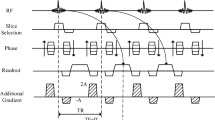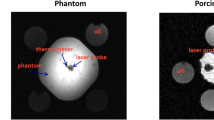Abstract
Objective
Recent years have seen an increased interest in combining MRI thermometry with devices capable of destroying malignancies by heat ablation. Expected from the MR protocols are accurate and fast thermal characterizations, providing real time feedback on restricted tissue volumes and/or rapidly moving organs like liver. This article explores the potential advantages of relying on spatiotemporally encoded (SPEN) sequences for retrieving real-time thermometric images based on the water’s proton resonance frequency (PRF) shifts.
Materials and methods
Hybrid spatiotemporal/k-space encoding single-scan MRI experiments were implemented on animal and human scanners, and their abilities to deliver single- and multi-slice real-time thermometric measurements based on PRF-derived phase maps in phantoms and in vivo, were compared against echo planar imaging (EPI) and gradient-echo counterparts.
Results
Under comparable acquisition conditions, SPEN exhibited advantages vis-à-vis EPI in terms of dealing with inhomogeneous magnetic field distortions, with shifts arising due to changes in the central frequency offsets, with PRF distributions, and for zooming into restricted fields-of-view without special pulse sequence provisions.
Conclusion
This work confirms the ability of SPEN sequences, particularly when implemented under fully-refocused conditions, to exploit their built-in robustness to shift- and field-derived inhomogeneities for monitoring thermal changes in real-time under in vitro and in vivo conditions.








Similar content being viewed by others
Abbreviations
- MRI:
-
Magnetic resonance imaging
- NMR:
-
Nuclear magnetic resonance
- FOV:
-
Field of view
- FT:
-
Fourier transform
- SPEN:
-
SPatio-temporal ENcoding
- PRF:
-
Proton resonance frequency
- STD:
-
Standard deviation
- SNR:
-
Signal-to-noise ratio
- SR:
-
Super-resolution
- SAR:
-
Specific absorption rate
- RF:
-
Radio frequency
- RO:
-
Readout
- PE:
-
Phase-encode
- SS:
-
Slice-select
- TE:
-
Echo time
- TR:
-
Repetition time
- EPI:
-
Echo-planar imaging
References
Hindman J (1966) Proton resonance shift of water in the gas and liquid states. J Chem Phys 44:4582–4592
Ishihara Y, Calderon A, Watanabe H, Okamoto K, Suzuki Y, Kuroda K, Suzuki Y (1995) A precise and fast temperature mapping using water proton chemical shift. Magn Reson Med 34:814–823
Quesson B, de Zwart JA, Moonen CTW (2000) Magnetic resonance temperature imaging for guidance of thermotherapy. Magn Reson Imaging 12:525–533
Cline HE, Hynynen K, Hardy CJ, Watkins RD, Schenck JF, Jolesz FA (1994) MR temperature mapping of focused ultrasound surgery. Magn Reson Med 31:628–636
Germer C, Isbert CM, Albrecht D, Ritz JP, Schilling A, Roggan A, Wolf KJ, Müller G, Buhr H (1998) Laser thermotherapy for the treatment of liver metastasis. Correlation of gadolinium DTPA-enhanced MRI with histomorphologic findings to determine criteria for follow-up monitoring. Surg Endosc 12:1317–1325
Gellermann J, Wlodarczyk W, Hildebrandt B, Ganter H, Nicolau A, Rau B, Tilly W, Fähling H, Nadobny J, Felix R, Wust P (2005) Noninvasive magnetic resonance thermography of recurrent rectal carcinoma in a 1.5 Tesla hybrid system. Cancer Res 65:5872–5880
Kuroda K (2005) Non-invasive MR thermography using the water proton chemical shift. Int J Hyperth 21(6):547–560
Cernicanu A, Lepetit-Coiffe M, Roland J, Becker CD, Terraz S (2008) Validation of fast MR thermometry at 1.5 T with gradient-echo echo planar imaging sequences: phantom and clinical feasibility studies. NMR Biomed 21:849–858
Kickhefel A, Roland J, Weiss C, Schick F (2010) Accuracy of real-time MR temperature mapping in the brain: a comparison of fast sequences. Phys Med 26:192–201
Bankson JA, Stafford RJ, Hazle JD (2005) Partially parallel imaging with phase-sensitive data: increased temporal resolution for magnetic resonance temperature imaging. Magn Reson Med 53:658–665
Yuan J, Mei C, Madore B, McDannold NJ, Panych LP (2011) Fast fat-suppressed reduced field-of-view temperature mapping using 2DRF excitation pulses. J Magn Reson 210:38–43
Holbrook AB, Santos JM, Kaye E, Rieke V, Butts Pauly K (2010) Real-time MR thermometry for monitoring HIFU ablations of the liver. Magn Reson Med 63:365–373
Holdsworth SJ, Skare S, Newbould RD, Guzmann R, Blevins NH, Bammer R (2008) Readout-segmented EPI for rapid high resolution diffusion imaging at 3T. Eur J Radiol 65:36–46
Roujol S, Ries M, Quesson B, Moonen C, de Senneville BD (2010) Real-time MR-thermometry and dosimetry for interventional guidance on abdominal organs. Magn Reson Med 63:1080–1087
Bernstein MA, King KF, Zhou XJ (2004) Handbook of MRI pulse sequences. Academic, Elsevier
Kunz D (1986) Use of frequency-modulated radiofrequency pulses in MR imaging experiments. Magn Reson Med 3:377–384
Pipe JG (1995) Spatial encoding and reconstruction in MRI with quadratic phase profiles. Magn Reson Med 33:24–33
Tal A, Frydman L (2010) Single-scan multidimensional magnetic resonance. Prog Nucl Magn Reson Spectrosc 57:241–292
Tal A, Frydman L (2006) Spatial encoding and the acquisition of high definition MR images in inhomogeneous magnetic fields. J Magn Reson 181:179–194
Ben-Eliezer N, Shrot Y, Frydman L (2010) High-definition single-scan 2D MRI in inhomogeneous fields using spatial encoding methods. Magn Reson Imaging 28(1):77–86
Ben-Eliezer N, Shrot Y, Frydman L (2009) Single-scan spatially encoded MRI—principles & applications. Proc Intl Soc Mag Reson Med 17:2670
Goerke U, Garwood M, Ugurbil K (2011) Functional magnetic resonance imaging using RASER. Neuroimage 54(1):350–360
Chamberlain R, Park JY, Corum C, Yacoub E, Ugurbil K, Jack CR Jr, Garwood M (2007) RASER: a new ultrafast magnetic resonance imaging method. Magn Reson Med 58(4):794–799
Ben-Eliezer N, Irani M, Frydman L (2010) Super-resolved spatially-encoded single-scan 2D MRI. Magn Reson Med 63:1594–1600
Ben-Eliezer N, Goerke U, Ugurbil K, Frydman L (2012) Functional MRI using super-resolved spatiotemporally-encoded imaging techniques. Magn Reson Imaging 30:1401–1408
Styczynski Snyder AL, Corum C, Moeller S, Powell N, Garwood M (2011) Gradient and frequency modulated excitation for a tailored spatial trajectory with two-dimensional time encoding for Fourier-free imaging. In: Proceedings of the 19th scientific meeting, international society for magnetic resonance in medicine, Quebec, p 4412
Ben-Eliezer N, Frydman L (2011) Spatiotemporal encoding as a robust basis for fast three-dimensional in vivo MRI. NMR Biomed 10:1191–1201
Rieke V, Butts Pauly K (2008) MR thermometry. Magn Reson Imaging 27(2):376–390
Griswold MA, Jakob PM, Heidemann RM, Nittka M, Jellus V, Wang J, Kiefer B, Haase A (2002) Generalized autocalibrating partially parallel acquisitions (GRAPPA). Magn Reson Med 47:1202–1210
Heidemann RM, Anwander A, Feiweier T, Knösche TR, Turner R (2012) k-space and q-space: combining ultra-high spatial and angular resolution in diffusion imaging using ZOOPPA at 7 T. NeuroImage 60:967–978
Nguyen T, Goerke U, Moeller S, Ugurbil K, and Garwood M (2009) Parallel imaging with RASER using multiband frequency-modulated excitation pulses. In: Proceedings of the 17th scientific meeting, international society for magnetic resonance in medicine, Honolulu, p 2738
Jezzard P, Balaban RS (1995) Correcting for geometric distortions in echo planar images from B0 variations. Magn Reson Med 34:65–73
Tal A, Frydman L (2007) Spectroscopic imaging from spatially-encoded single-scan multidimensional MRI data. J Magn Reson 189:46–58
Schmidt R, Frydman L (2012) In vivo 3D spatial/1D spectral imaging by spatiotemporal encoding: a new single-shot experimental and processing approach. Magn Reson Med. doi:10.1002/mrm.24470
Acknowledgments
We are grateful to Dr. Noam Ben-Eliezer for help in the initial stages of this work, and to Koby Zibzener and Talia Harris for their help in setting up the experiments. This research was supported by the Israel Science Foundation (ISF 447/09), the Minerva Foundation (Project 710587; Federal German Ministry for Education and Research), a Helen and Martin Kimmel Award for Innovative Investigation, and the generosity of the Perlman Family Foundation.
Author information
Authors and Affiliations
Corresponding author
Electronic supplementary material
Below is the link to the electronic supplementary material.
10334_2013_372_MOESM1_ESM.docx
Magnitude images (top row) and temperature maps derived from spin-echo EPI and Hybrid SPEN thermometry experiments in an inhomogeneous environment. Distortions in Bo were achieved by placing a titanium non-magnetic plate next to bigger water tube; a smaller one kept at constant temperature and a bigger one undergoing cooling. The vertical progression shows temperature maps at time = 0, 3, 10 min into the process. Common scan parameters: FOVs = 25 mm, resolution 0.35 × 0.35 mm (pixel matrix 70 × 70), τo = 5 ms, Tacq = 30.8 ms. For the 90° chirp Hybrid SPEN Texc = 26.8 ms, Gexc = 0.92 G/cm. (DOCX 539 kb)
Rights and permissions
About this article
Cite this article
Schmidt, R., Frydman, L. Alleviating artifacts in 1H MRI thermometry by single scan spatiotemporal encoding. Magn Reson Mater Phy 26, 477–490 (2013). https://doi.org/10.1007/s10334-013-0372-9
Received:
Revised:
Accepted:
Published:
Issue Date:
DOI: https://doi.org/10.1007/s10334-013-0372-9




